I love my manual focus Leica mount lenses, they are increasingly the main reason why I keep my m-mount digital cameras. With that said, sometimes I go through phases where my appreciation for autofocus cameras and lenses increases, and the Leicas and M lenses spend more time on the shelf. I’m going through one of those phases at the moment. I’ve been shooting my Sony RX100VII and A7III more than anything else in my cupboard for a good few months. All this is part of the reason I was so excited to read about the new Techart Pro LM-EA9 lens adapter; an adapter that allows M-Mount lenses – and other lenses with further adapters – to be mounted to a Sony camera with the addition of autofocus capability.
Now, you might already be aware of such adapters. Techart have had an adapter that offers such functionality on the market for a few years in the form of the LM-EA7. There’s also at least one copy of this adapter on the market too I believe. In fact, I had hung my mouse over the buy button on one of these adapters quite a few times since they were released, but for a few reasons, I never committed.
The issue with the LM-EA7 are fairly widely reported, but this thread on Fred Miranda is definitely the best resource. As you will read if you dig into that thread, users have has issues including mechanical sagging or “wobble” of the lens adapter, loose screws on the mount, the adapter getting jammed on cameras, battery drain even when the camera is switched off, the size of the adapter getting in the way of users tripod mounts and L-brackets, and perhaps most significantly, the adapter not working on later model cameras and later firmware versions after Techart stoped updating the firmware of the adapter. For all that, some users still sing the praises of the LM-EA7, but for my money I’ve always eventually just decided to hold out for an updated version to see if these issues would be fixed. Enter the Techart Pro LM-EA9.
Almost as soon as I was aware of this new version adapter coming to market, I emailed them to ask if they would be happy to send me one for review purposes. They agreed, and a few weeks ago I received a review copy in the post.
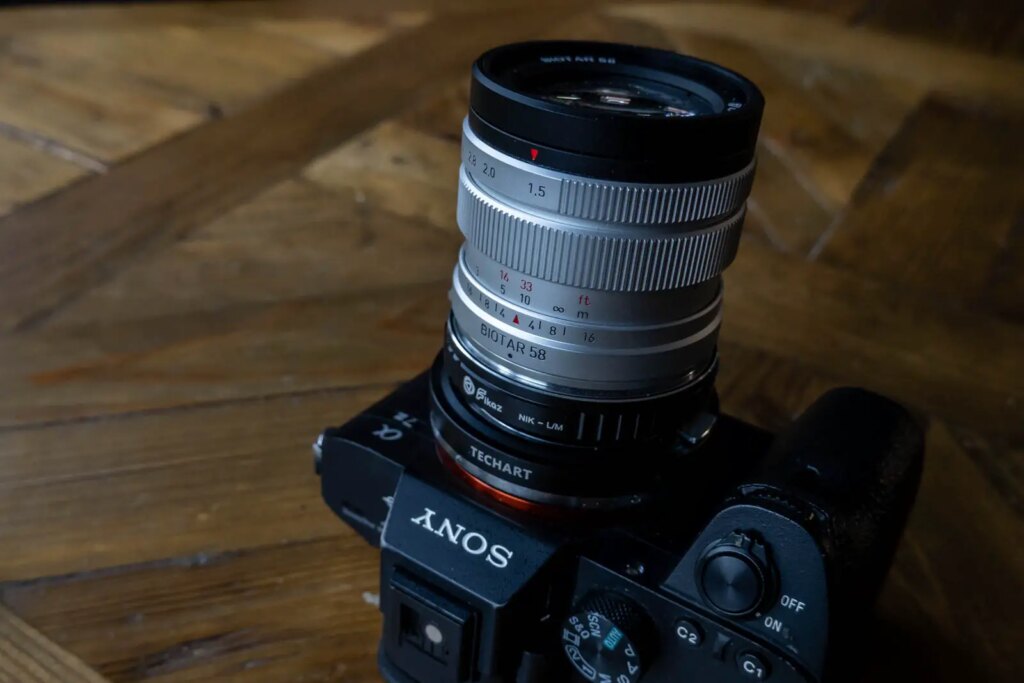
How the Techart Pro LM-EA9 works
I shall get to my impressions of this new adapter in a moment, but first it seems sensible to describe the way it works. Autofocusing manual focus lenses isn’t witchcraft, it’s actually quite a simple process, at least depending on the simplicity of the design of the lens mounted.
Fortunately, the large majority of rangefinder lenses – and other vintage manual focus lenses for that matter – have relatively simple optical formulas where all of the optics within the lens move together backwards and forwards when the lens is focused toward infinity and the minimum focus distance respectively. These sorts of lenses are known as ‘unit focusing’ lenses. The Techart Pro LM-EA9 is designed to work with unit focusing lenses.
When mounted on a camera, all m-mount lenses, regardless of focal length, mount at the same distance from the body of the camera. When set at infinity, regardless of the lens, the optics are at their closest position to the sensor or film. When you rotate the focus ring of a unit focusing lens to focus closer, the mechanics of the lens move the elements away from the sensor or film. The elements all move together more or less depending on the focal length. Wide angle lenses need only to move forward a small distance to reach their closest focus capability, longer lenses move their elements much further away.
The Techart Pro LM-EA9 works by mounting the M-Mount lens to a Sony camera at the correct position for accurate infinity focusing. That is to say, if you just used it as a dumb manual focus adapter, and focused the lens manually you would get the lens’s normal minimum focus distance all the way to infinity as you would if mounting the lens on a Leica RF mount camera. The trick that the LM-EA9 has up it’s sleeve is that it can also move the whole lens forward and backwards on a set of 4 built-in motors that are powered by the Sony cameras autofocus system.
Because all of the optics in a unit focusing lens move at the same time, there is therefore no difference in terms of image quality whether the optics are moved by the lens’s mechanism or the adapter. Mount the lens to the adapter and set it to infinity and when you press the button to autofocus the lens, the adapter moves the optics in effectively the same way as they are moved when turning the focus ring. Which is how the Techart LM-EA9 autofocuses manual focus lenses. Simple, right? Well, there are some limitations.
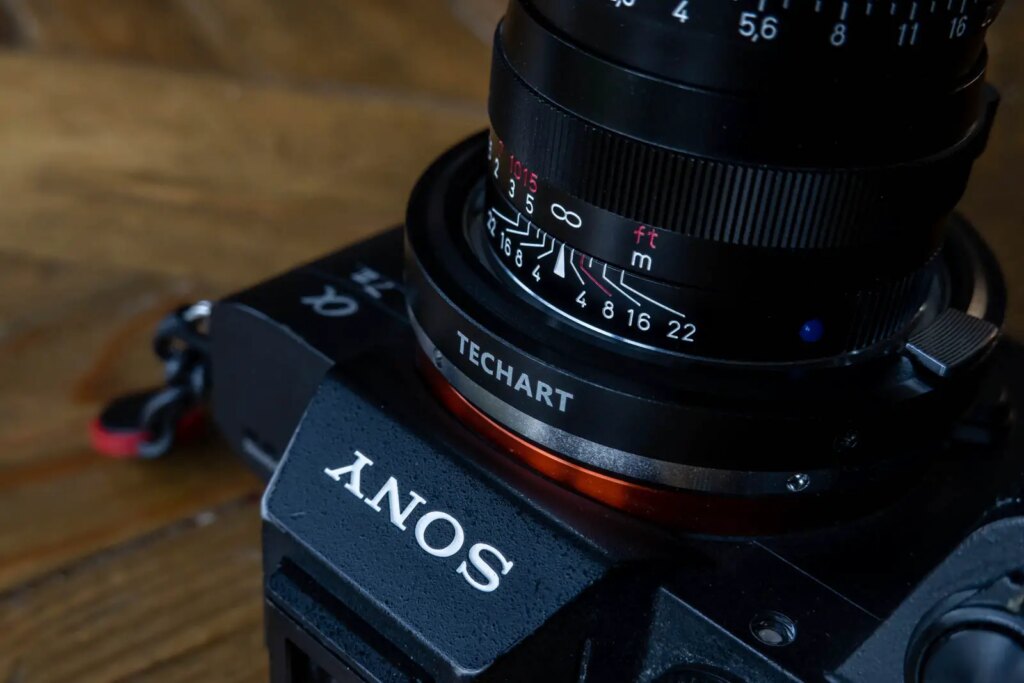
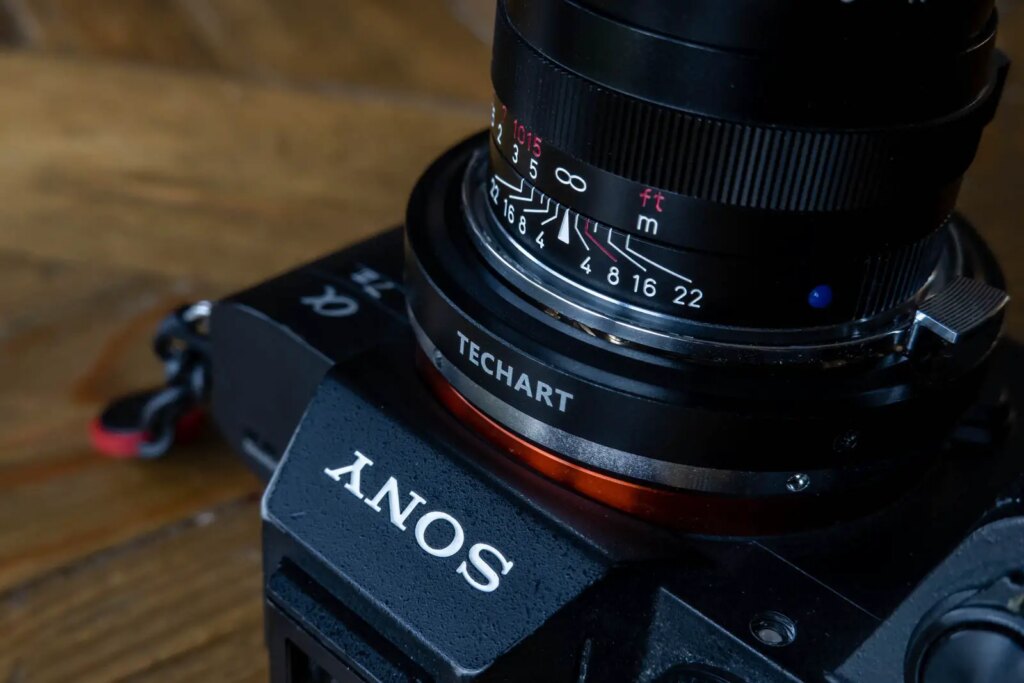
Comparison of lens near and far focused on LM-EA9 Adapter
Focal Length Limitations
Possibly the most significant potential limitation of the Techart Pro LM-EA9 is how far the adapter can move the lens forward or backward. Regardless of the lens attached, the amount it moves forward and backward is always limited to a maximum of 4.5mm. The result of this has advantages for wide angle lenses which are able to focus closer than their usual minimum focus distance (MFD) and disadvantages for telephoto lenses which aren’t able to reach their MFD when using the motors in the adapter alone.
So, for example, where a 35mm rangefinder lens that might normally be limited to a 0.7m MFD, on the Techart Pro LM-EA9 the motors can move the lens forward enough to achieve a ~0.4m MFD. Conversely, if you mount a 90mm lens, the 4.5mm of movement will only achieve a ~2m MFD. The result of this is that to achieve closer focusing, longer lenses need to be preset at a closer distance than infinity when mounted on the adapter.
Here you can see the focusing ranges with the focus on lens is set to infinity:
15mm: 6.5cm – Infinity
21mm: 12cm – Infinity
24mm: 15cm – Infinity
28mm: 20cm – Infinity
35mm: 31cm – Infinity
50mm: 60cm – Infinity
90mm: 1.8m – Infinity
135mm: 4.2m – Infinity

Lens type limitations
Alongside unit focusing lenses, there are essentially two other types of lenses in terms of how they focus. These are front element focusing lenses and internal focusing lenses. Front element focusing lenses just move the front element to focus. We can largely ignore these when dealing with rangefinder lenses, as I don’t think there are any that work like this. It might be something to consider with other classic lenses though, as if they do focus like this, they wouldn’t work on this adapter because all the optics would be moved instead of just the front one.
Then there are internal focusing lenses to think about. When you turn the focus ring on an internal focusing lens, the mechanism inside moves some of the elements differently to the front and rear groups. If you try to use one of these types of lenses on a Techart Pro LM-EA9, where focusing is achieved by moving the whole lens back and forth, there will be an impact on the image quality that the lens is capable of due to the fact that the internal optics will remain in a fixed position rather than doing the job they’re supposed to. In the world of rangefinder lenses, these sorts of lenses are often known as floating lens element (FLE) lenses.
Dumb Mount/Lens Limitations
It’s also worth noting that m-mount cameras and lenses are built around a platform the doesn’t communicate the lens’s set aperture to the camera, or anything else to the camera body. Nor, when mounting these lenses to other systems, does the camera’s set aperture effect the lens. When using the LM-EA9 this means that the lens’s set aperture won’t be relayed to the camera and stored in the meta data. It also means that if you want the focal length information stored, you need to set the adapter to tell the camera what the lens is using the settings features.

Techart Pro LM-EA9 settings
The Techart Pro LM-EA9 has a couple of settings. The first and potentially most useful is the ability to set the focal length of the lens that’s mounted. This is useful for meta data purposes, but is also apparently beneficial for the cameras stabilisation features to know when the focal length is.
When shooting, the camera should always be set to f/2- this is regardless of the lens’s selected aperture. Deviation from this will result in incorrect exposure.
Setting of the camera to other f/stops is how the LM-EA9 adapter settings are accessed. Most of the selectable apertures are for defining the lens’s focal length. Set the camera to the aperture that corresponds to the focal length, fire a shot, reset to f/2 and that’s the focal length that the metadata will contain.
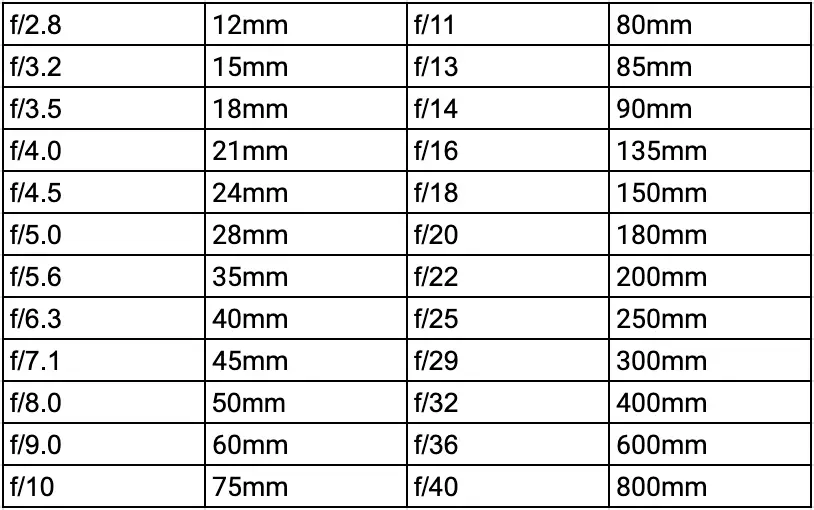
It is also possible to set a slower or faster focusing mode with the slower one supposedly being more precise for faster lenses shot wide open. F/51 for normal, f/57 for fast. Finally, there’s a lens parking position setting at f/45. To be completely honest, I don’t know what this parking position setting does. It didn’t seem to do anything for me. And actually, the focusing speed change didn’t seem to do much either. Perhaps I was doing something wrong. That said, I didn’t bother setting the focal length either. I’m not fussed about the focal length being noted in the metadata anyway, and the steadyshot seemed fine. In short, I didn’t really worry too much about the settings features. Your mileage might well vary…
Techart Pro LM-EA9 vs EA7
Obviously, I’m not comparing these adapters based on experiences with both, but to my eye there are a series of obvious improvement when comparing these two adapters. Techart Pro have seemingly set out to solve the issues I talked about above.
To kick off, instead of the adapter driving the lens with one motor it’s now driven with four motors. I expect the goal here is, at least in part, to strengthen the adapter to stop the wobble. Interestingly, they seem to have lowered the weight limit of the adapter too. I think the old adapter was officially limited to 700g lenses, this new one lists 500g as the limit, and when I asked Techart directly, they said 300g was the limit if you wished to ensure maximum focusing speed. I guess they have learned to be a little more conservative in their specifications based on what happened to the LM-EA7, but hopefully this new design will prove stronger too.
Loose screws and the mount jamming on the camera is an issue I have yet to experience with the LM-EA9. Reading that thread on FM, it sounds like people were carrying little screwdrivers around with them to tighten the mount onto the adapter. Sounds crackers to me, so I really hope this is something Techart Pro have fixed with the new LM-EA9.
I can also confirm that the LM-EA9 doesn’t seem to drain the camera battery when not in use. I’ve certainly not noticed this happening, and I’ve left the adapter on the camera for days at a time without using it. It also works fine on my Sony A7iii and my work’s Sony A7iv.
Finally, the new compact design shouldn’t interfere with L-brackets or tripod mounts – certainly no more than any other lens mount adapter.

Techart Pro LM-EA9 Design and Build
In fact, this latter point is something that really attracted me to this mount adapter over the previous design. As much as I understood why the previous model needed to have that casing hanging off the bottom, it always reminded me of one of the weird early autofocus lenses. Canon’s FD mount AF lens comes to mind, though there were a few more. They were usually shaped with bulges that contained the mechanism for automatically moving the optics. I thought we were past that era a long time ago, but the LM-EA7 brought it back. Thankfully, the Techart Pro LM-EA9 does away with bulges, and is not really that much bigger than other lens mount adapters, if at all.
It also feels really well built. All of the outer parts are made of metal. The mount to the camera is a nice fit, with no play at all on my copy when mounted to my Sony A7iii. The lens mount is also a good fit, and though there is a little bit of play, there’s certainly nothing that would concern me.
The only concern I have is when the adapter extends to its minimum focus position. When this happens, a small gap around the mount opens up. I’m not sure exactly what I can see in that gap, and it’s not like any of my m-mount lenses are weather sealed either, but it is quite a big gap and it did make me wonder what might happen if a bit of grit or something got in there…? Fortunately, the LM-EA9 retracts fully when switched off which I guess helps prevent any issues when the lens is stowed.
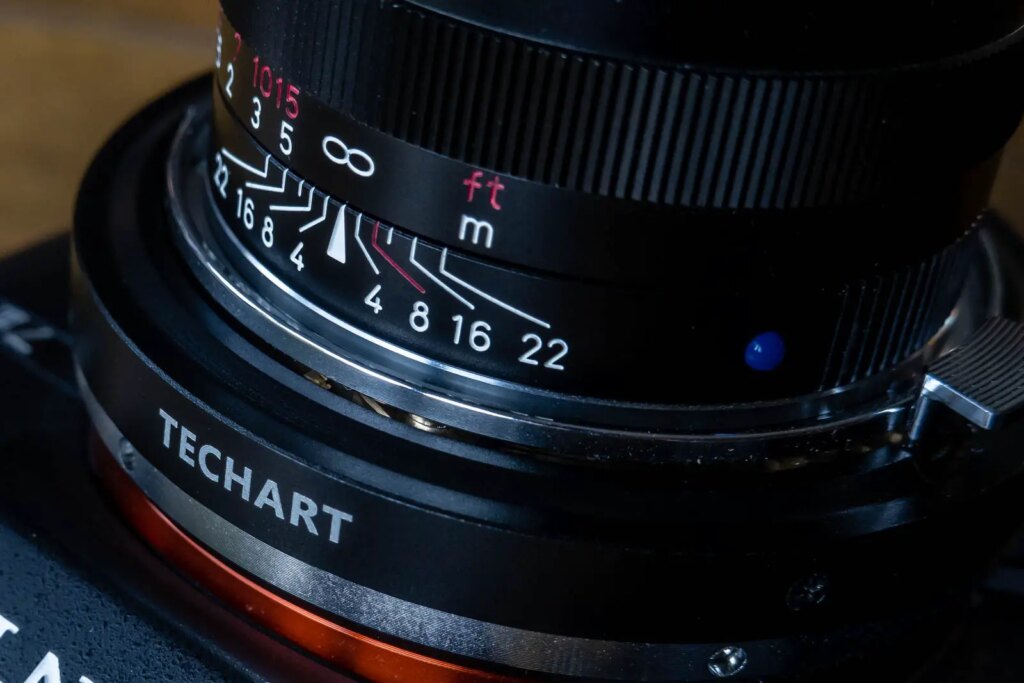
Shooting with the Techart Pro LM-EA9
All of that waffle out of the way, you might want to know what it’s like to use…? I have to say, having never seen it’s predecessor or any of the copies in real life, I was supper-intrigued. And actually I ended up pleasantly surprised by the sum total of what it brought to the table.
Unfortunately, when I first mounted it, I found myself a little uninspired. The first lens I used was the Omnar NK35-25 (the Nikonos 35mm lens rehoused for Leica). With this lens attached, I found the autofocus to be a bit twitchy and often found it hunting more than I would have liked. I soon realised there was a firmware update. Once updated, things became a lot better. With the same lens attached, focusing worked much better.
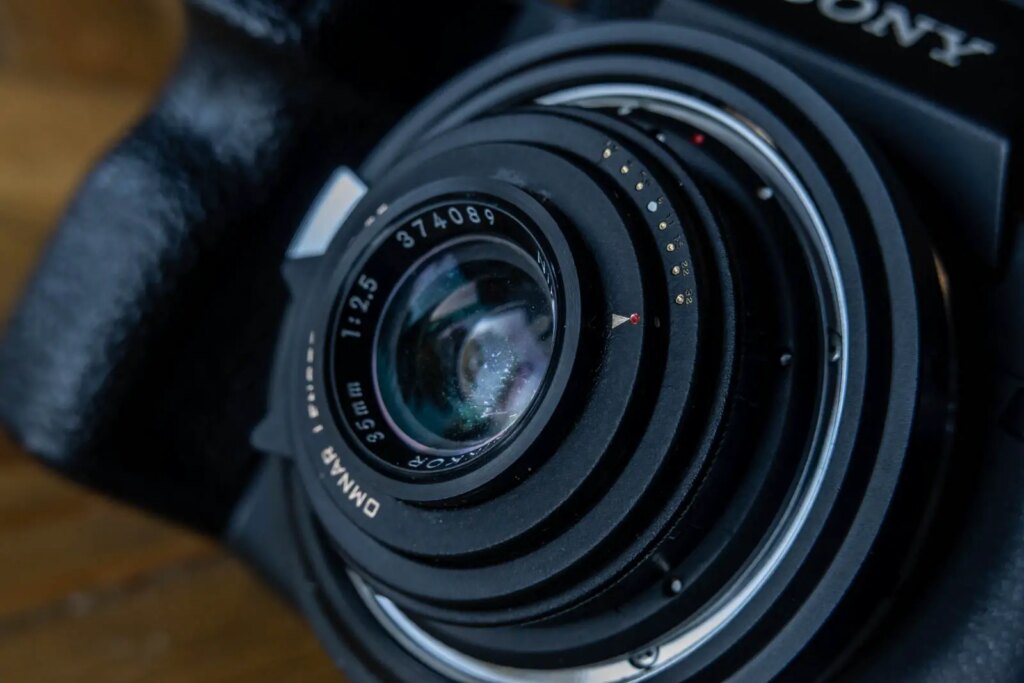
Of course, it’s a world apart from focusing a “proper” Sony AF lens. I’ve just picked up the 24-70 GM II Sony lens and, wow(!!), that thing focuses quickly. If you’re used to that sort of autofocus, this adapter is going to disappoint you for sure. But, that’s just not what the deal is here. If you acknowledge that you’re focusing lenses that were never meant to be auto focused using a £300 adapter, then you might find yourself a little more impressed.
Certainly in most circumstances focusing works well enough, though sometimes for reasons I can’t quite put a finger on, it just refused to find focus for me, or at very least struggled. There’s perhaps some correlation with the amount of light, with lower light being worse, but even in good light it seems to occasionally falter. I’ve also found that it’s also worth sticking to the centre focusing point. Moving beyond the centre can exacerbate the focusing issues, though I suppose it’s fair to say the points closer to the centre work pretty well too. For me though, just using a focus and recompose method rather than moving the point around was more effective. Frustratingly, I wouldn’t find this an issue on a lot of cameras, but my habit with the Sony is often to use the touch screen to move the focus spot wherever I want it quite quickly. This method of shooting just didn’t work for me with the LM-EA9, so I had to reconfigure my Sony shooting process slightly to get the best experience out of the autofocus.

Overall, I suppose it feels a little like an older autofocus system – like something you might find on a 90s AF SLR. It’s good enough to work with most of the time, and certainly reaps great results a lot of the time, even with very fast lenses that can be quite hard to focus manually. But you just have to be patient sometimes and approach using it with expectations set appropriately.
AF-S vs. AF-C
Just a quick note on AF-S vs. AF-C focusing modes. I wasn’t expecting much from switching the camera to AF-C, assuming that still subjects would be my main subject matter. Actually, I had some luck using the camera in AF-C shooting moving subjects. Again, it’s about expectations. If you want proper AF-C for subject tracking, you might be barking up the wrong tree, but if you’re looking for the occasional ability to photograph a moving person – an excitable 7 year old daughter for example – you’ll probably be ok.
Close focus benefits
I must say, I’ve also really enjoyed the ability to focus a few of the lenses I’ve been shooting recently closer than they are supposed to. This is specifically the case with the Meyer 58mm 1.5 Biotar that I’ve also been reviewing recently. That lens has a 70cm MFD, but with the Techart Pro LM-EA9, it can focus a fair bit closer which has allowed me to shoot that lens outside of how it was designed and get some really nice results. It really has beautiful out-of-focus rendering that lens, so closer focusing has given me some great results. More on that in a future review.

Of course, to do this, you have to consciously adjust the manual focus to a closer distance before activating the autofocus, but in practice I’ve found this to be quite easy. There’s no need at all for precision, you can just rotate the manual focus a load in the general direction and then try the AF. The only time I have found myself struggling has been when I’ve then gone back to focusing at something within the normal focusing range and I’ve wondered why the adapter is hunting. It is, in fact, getting used to this process that helped me discover the way I found shooting longer lenses most successfully.
Longer lens focusing in practice
As mentioned above, the 4.5mm of movement isn’t enough to focus anything longer than 50mm for the full 70cm to infinity range. As such, there is a need to adjust the lens manually when moving from further to nearer distances. How much this is an issue is simply proportionate to the length of the lens. The longer the lens, the less of the total range the LM-EA9 can handle. Therefore, with longer lenses the process of focusing becomes more of a manual focus to close-to-focused with an autofocus tweak at the end. I actually quite like focusing like this, and found it quite easy especially with the camera at waist level using the distance scale to guess distance and then the screen with AF for fine tuning. I should say though, the maximum length of lens I tried this with was 105mm – though with that being my 105mm Nikon Sonnar, I was very happy with the results!

Switching to Manual Focus
I have my Sony A7iii set up so the delete button switches the camera temporarily into manual focus and activates focus peaking. Having the camera setup like this means if the autofocus really isn’t working, or you want to switch to zone focusing etc, you can switch between shooting methods literally at the click of a button.
The LM-EA9 Extension Tube
With the camera in manual focus mode, you can also use the Techart Pro LM-EA9 is as a simple extension tube too. With the lens set to infinity, if you focus on something close up then switch the camera to manual focus, you can then manually focus the lens to closer distances. I haven’t done this myself, but it seems like a nice fringe benefit, especially given the price of decent quality mechanical extending adapters.
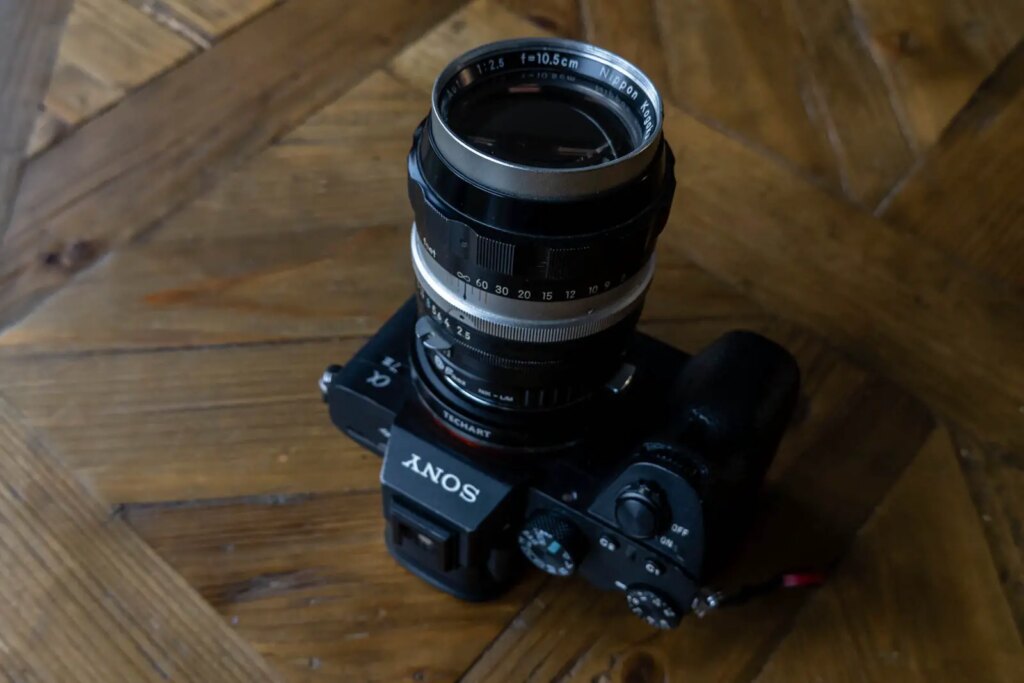
Adapting Non-M-Mount lenses
As I am sure is clear from what I have so far written, it is also possible to adapt other mount lenses to this adapter. So for example, as mentioned I have mounted the 58mm 1.5 Biotar I have on load from Meyer Optik Gorlitz at the moment. I have also mounted my Nikon 105mm 2.5 lens. As long as the lens you choose isn’t excessively heavy, has an aperture that can be set to be manually controlled, and can be adapted to m-mount, this adapter can be used. In fact, I’ve actually ended up using it more with non-m-mount lenses for the benefit of this review more than I have with m-mount lenses.
A Few More Sample Photos


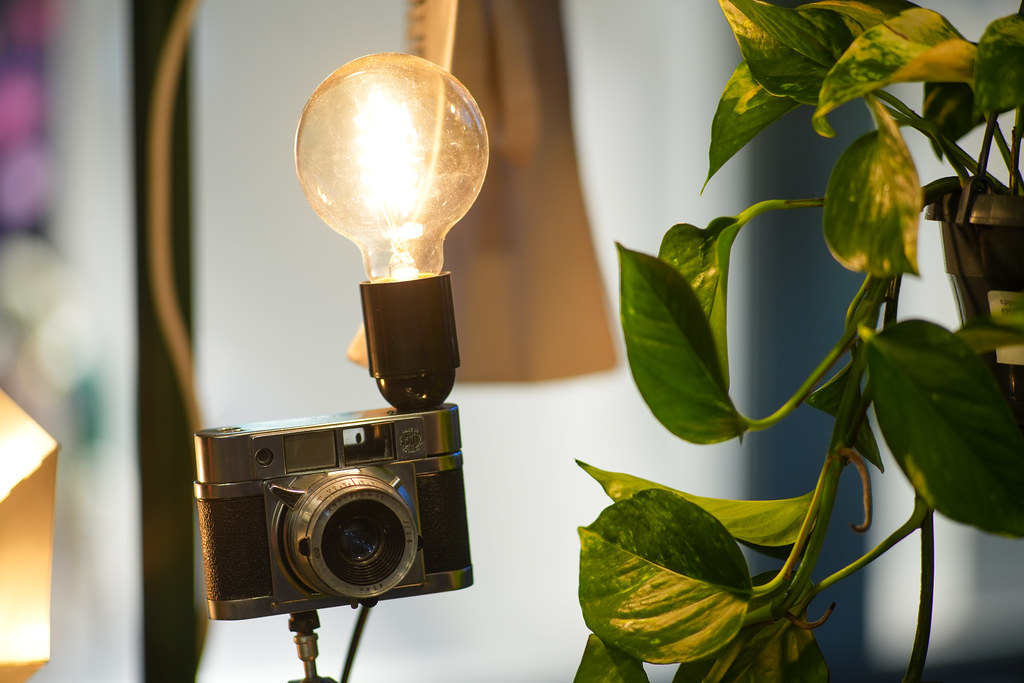

Final Thoughts
I love this lens adapter! The Techart Pro LM-EA9 adapter is a great little gadget that I think brings a few extra tricks to the table for anyone who like to adapt classic lenses to their Sony cameras. I started this review thinking I was simply looking at an autofocus adapter for M-Mount lenses, ideally less than 50mm in focal length. It’s possibly true that this is it’s sweet spot, but actually I’ve found myself more than comfortable using it with longer lenses and lenses made for other mounts too.
Ok, it’s fairly obvious that lots of different types of lenses can be mounted to it, and I was intrigued to play around trying. What I didn’t expect to find was just how useful it would be with longer lenses. The on-paper limitation of 50mm before you have to start manually focusing might sound like it might be frustrating, but actually in practice I’ve found it not to bother me at all. The little technique I found for pre-focusing to an approximate distance, then using the AF to quickly fine tune worked out to be a lot quicker than my usual manual focus techniques alone, and my hit count has been slightly higher too. This goes for all the lenses I mounted to it. Add to this the closer-focusing capabilities it brings to the table, both in AF and MF modes, and this adapter feel like it bring a lot more to the table than I was expecting.
Of course, time will tell on the build quality, but it certainly seems to have solved the most commonly highlighted issues with its predecessor. It’s also true that you definitely need to set your expectations at something a good bit less than the autofocus capabilities of a modern dedicated AF lens. But for me, that’s no real issue – not least because I’m used to shooting the more antiquated AF systems I think it’s probably somewhat comparable to in terms of speed and accuracy.
Aside from any of these details though, I’ve just found the Techart Pro LM-EA9 to be a lot of fun to use. I feel like it’s opened up a whole new world of potential for me for shooting older lenses in a slightly more enjoyable way. I shall definitely be adding one to my box of lens adapters!
You can find this adapter on Techart’s website here
Update: Jammed/Stuck Adapter + Fix
Just a day or so after I finished this review, the Techart Pro LM-EA9 I had for review jammed. That is to say, it stopped moving when the AF should trigger it to do so. Instead, it just made a very subtle clicking noise. I emailed Techart, and after a little wait and an additional email-nudge I got a response with a fix. Just in case anyone else has this issue, I thought I would share it here. The following is verbatim what I received, and it did indeed fix the issue.
There were some cases like this and we have found the solution to reset the adapter. Let’s try if it works. Please download the firmware as attached and follow the following procedure to reset:
- Connect the adapter to computer
- Open the firmware update software
- Select firmware 1.5 and click update button at the bottom of the software interface
- Wait until the loading bar completed and notification popping up.
- Disconnect the adapter
- Put on the adapter with lens on the camera and take a picture at camera aperture f/90. The adapter may not be focusing so in order to release the shutter you may need to adjust the focus point manually.
- Turn the camera aperture to the minimum and take another picture. At this point, usually the adapter has been reset and the extension plate should be working. If not, turn off the camera and turn it on again to try. If still not, redo step 6.
- When the adapter is focusing normally, please connect it again to the computer and update the adapter to firmware 1.6. It should be free of freezing again with v1.6.
Note, at the time of publishing, v1.6 was the latest firmware.
Update: Vignetting
Since writing this review, I have discovered that when used in combination with some secondary adapters and some lenses, there can be a slight issue with vignetting. eg:

This was taken with the Meyer 58mm 1.5 Biotar which I initially blamed for the issue. I have since found I also get the same vignetting when mounting my Nikon 135 3.5 pre-ai. Unusually, I don’t get the issue when mounting my Nikon 105 2.8 pre-ai using the same adapter.
Share this post:
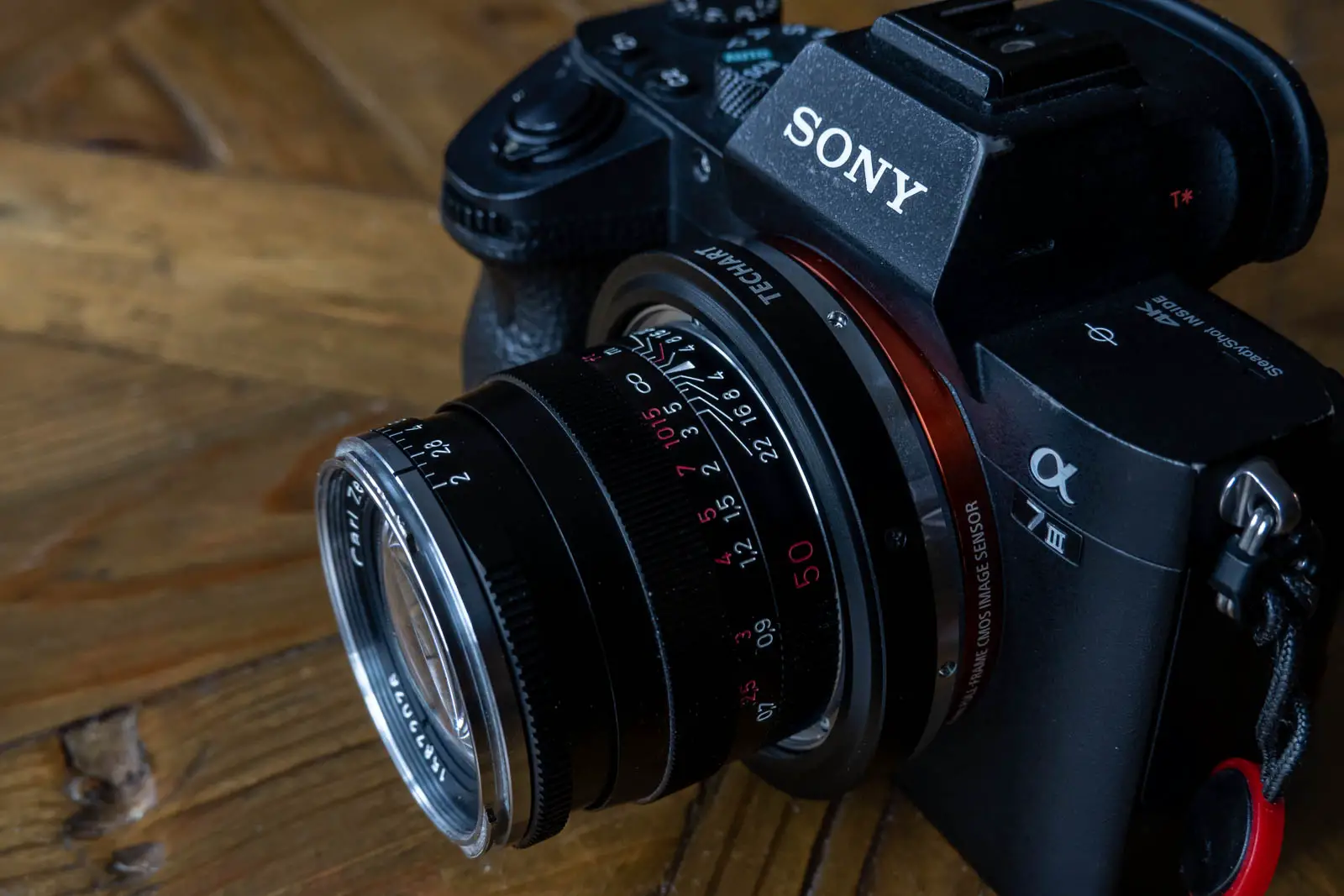
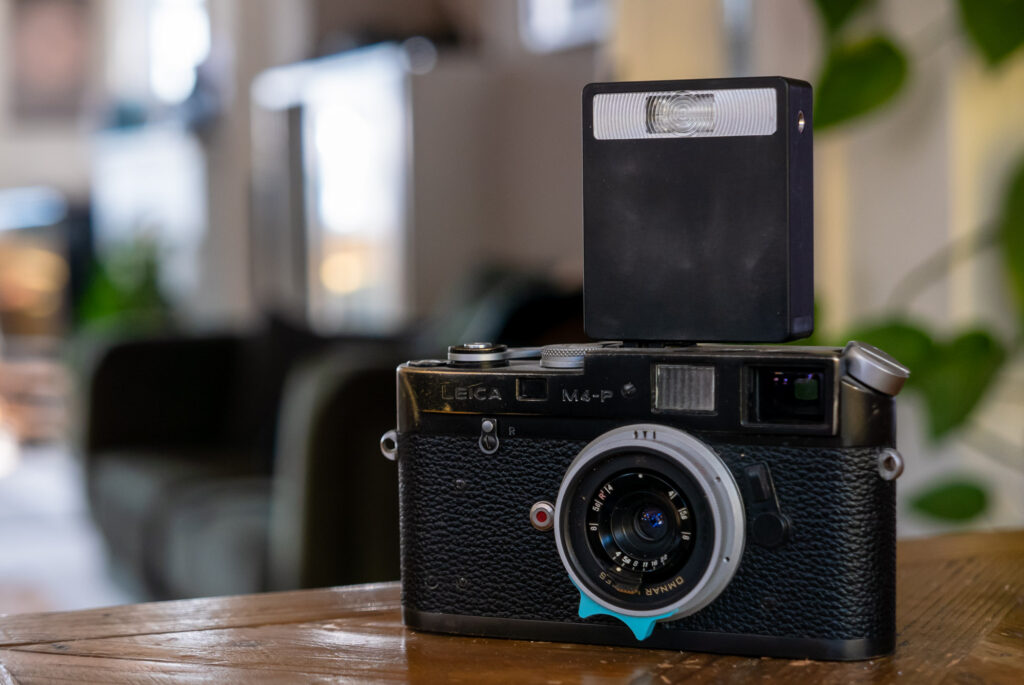
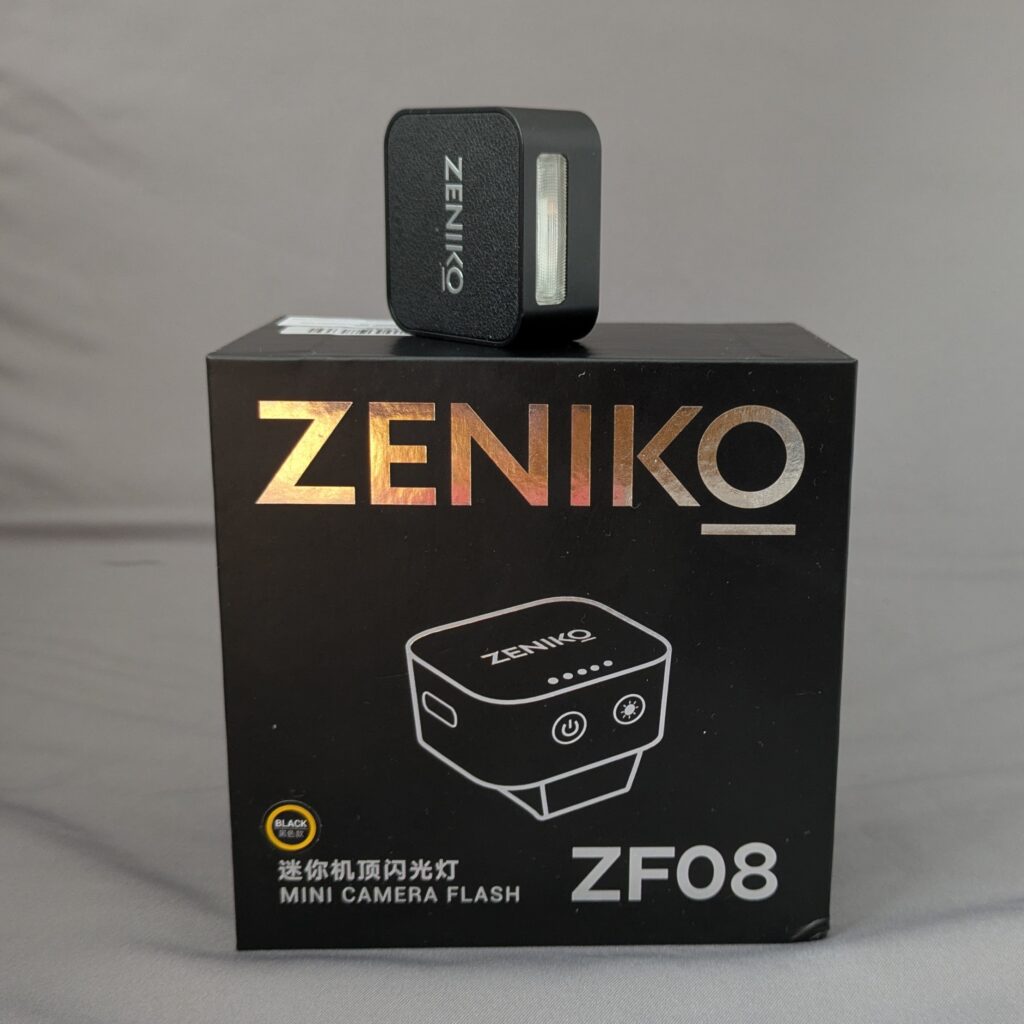

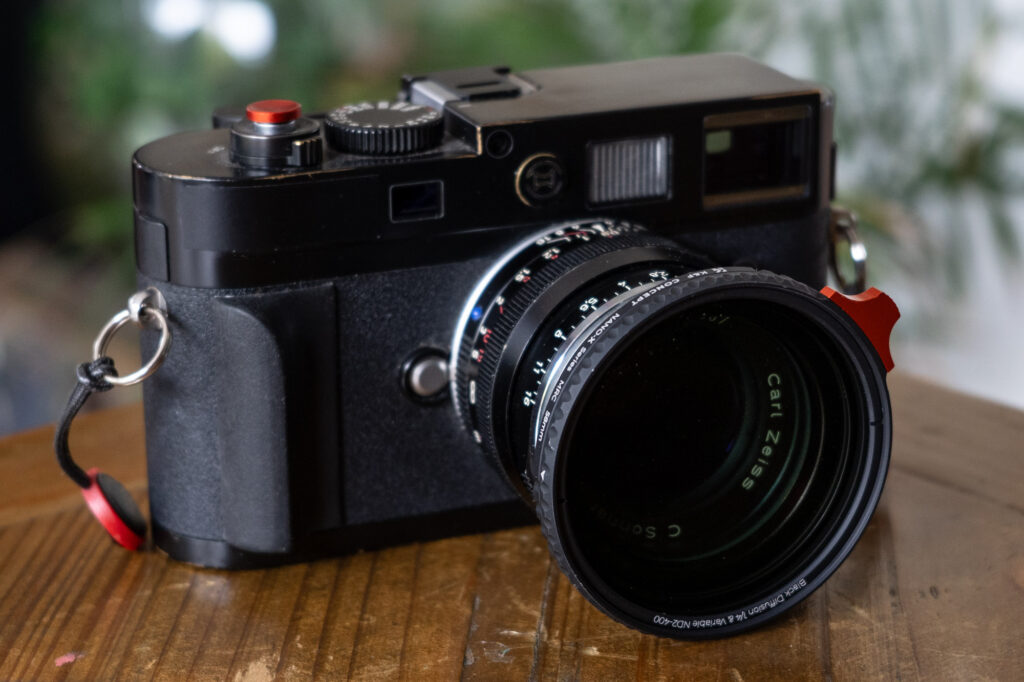




Comments
Eric on Techart Pro LM-EA9 Auto Focus Lens Adapter Review
Comment posted: 27/11/2022
Comment posted: 27/11/2022
Rob Tweed on Techart Pro LM-EA9 Auto Focus Lens Adapter Review
Comment posted: 24/02/2023
Have you had any more long-term experience with it that you can share? Is it still working reliably for you - or did you have to return it as a review model?
Cheers and thanks for any thoughts
Comment posted: 24/02/2023
Marc L'Esperance on Techart Pro LM-EA9 Auto Focus Lens Adapter Review
Comment posted: 09/03/2023
I had been considering an EA9 for some of the improvements over the EA7 but this factor has dampened that enthusiasm, as 135 is a focal length I enjoy and so far the functionality of the EA7 has been great on my A7C. I suppose at some point if I get the A7C II when it comes out the situation may change..
Comment posted: 09/03/2023
Comment posted: 09/03/2023
Comment posted: 09/03/2023
Stefan on Techart Pro LM-EA9 Auto Focus Lens Adapter Review
Comment posted: 17/04/2023
Comment posted: 17/04/2023